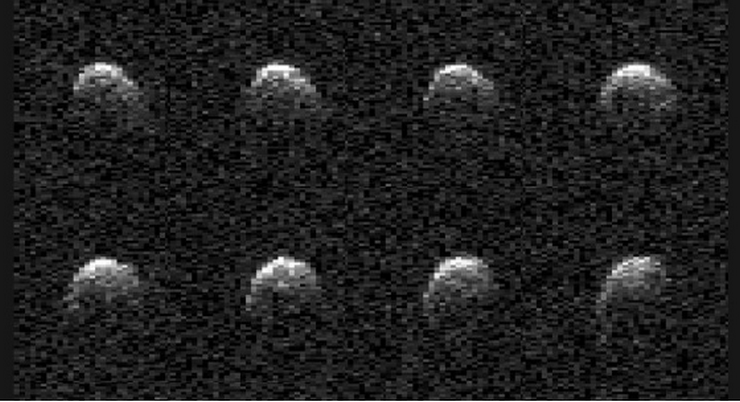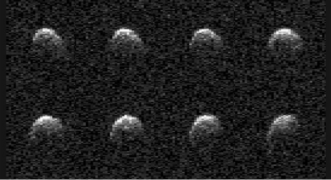
The day before asteroid 2008 OS7 made its close approach with Earth on Feb. 2, this series of images was captured by the powerful 230-foot (70-meter) Goldstone Solar System Radar antenna near Barstow, California. [NASA/JPL-Caltech photo]
On Feb. 2, a large asteroid safely flew past Earth at a distance of about 1.8 million miles, or 7 ½ times the distance between Earth and the Moon. While there was no risk of the asteroid hitting our planet, a team of scientists at NASA’s Jet Propulsion Laboratory in Pasadena seized the opportunity to study this near-Earth object (NEO) in unprecedented detail.
Using a powerful radio antenna, the JPL team obtained the first high-resolution images of the asteroid, named 2008 OS7, revealing its size, shape, rotation, and surface features. The images show that the asteroid is about 500 to 650 feet wide and has a mix of rounded and more angular regions with a small concavity. The asteroid also rotates very slowly, taking about 29 ½ hours to complete one full turn.
The radio antenna used by the JPL team is part of the Goldstone Solar System Radar, located at the Deep Space Network’s facility near Barstow, California. The Goldstone radar is one of the few instruments in the world capable of imaging NEOs with such precision and clarity. It works by bouncing radio waves off the asteroid and analyzing the echoes that return to Earth.
The Goldstone radar observations also provided key measurements of the asteroid’s distance from Earth as it passed by. Those measurements can help scientists at JPL’s Center for Near Earth Object Studies (CNEOS) refine calculations of the asteroid’s orbital path around the Sun. CNEOS, which is managed by JPL, calculates every known NEO orbit to provide assessments of potential impact hazards.
Asteroid 2008 OS7 was discovered on July 30, 2008, by the NASA-funded Catalina Sky Survey, which is headquartered at the University of Arizona in Tucson. The asteroid orbits the Sun once every 2.6 years, traveling from within the orbit of Venus and past the orbit of Mars at its farthest point.
The JPL team plans to continue using the Goldstone radar to image more NEOs in the future, as well as other solar system objects such as comets, moons, and planets.
By doing so, they hope to advance our understanding of the solar system’s origins, evolution, and diversity, and to help protect Earth from any potential threats from space.














 0 comments
0 comments


